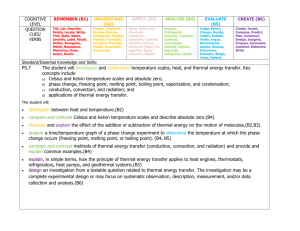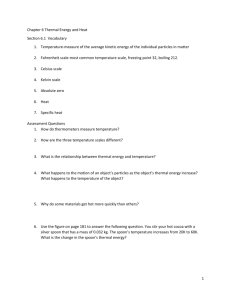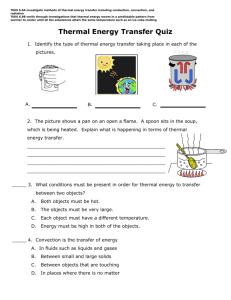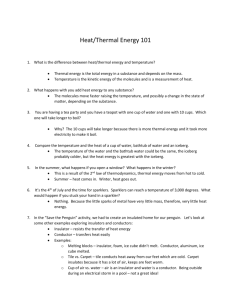File - Mr. Conyers' 8th Grade Science Class
advertisement
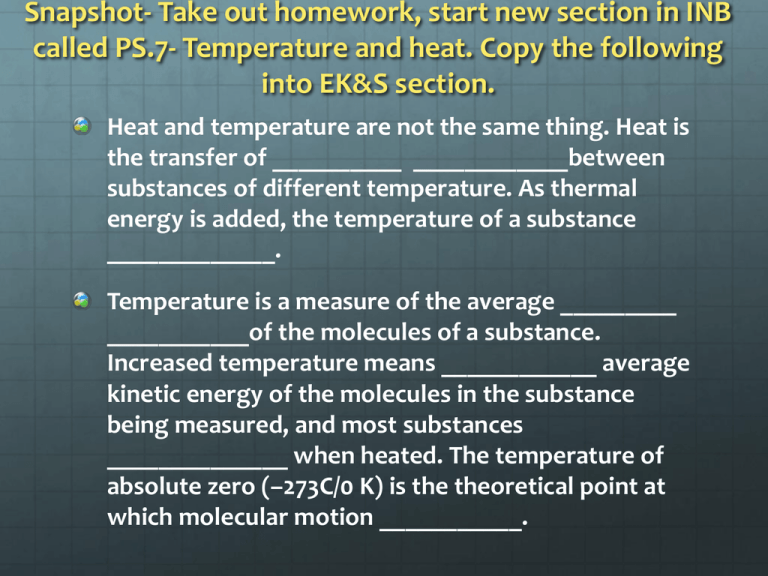
Snapshot- Take out homework, start new section in INB called PS.7- Temperature and heat. Copy the following into EK&S section. Heat and temperature are not the same thing. Heat is the transfer of __________ ____________between substances of different temperature. As thermal energy is added, the temperature of a substance _____________. Temperature is a measure of the average _________ ___________of the molecules of a substance. Increased temperature means ____________ average kinetic energy of the molecules in the substance being measured, and most substances ______________ when heated. The temperature of absolute zero (–273C/0 K) is the theoretical point at which molecular motion ___________. Snapshot 1. What type of energy is stored in your body’s cells? 2. Energy cannot be ________ or _________ it can only be ___________. 3. Radiant energy is a type of _____________ energy. 4. What energy transformations occur when you turn on a hair dryer? 5. What energy transformations occur when you burn a candle? Test After test work on the Benchmark study guide Due Monday! Snapshot Alex wanted to know if adding different amounts of salt to ice would make the ice melt faster. 1. What is the independent variable? 2. What is the dependent variable? 3. What are three things that should be constants? Energy Organizer Two States of Energy Seven forms of energy: Examples: Energy Organizer Two States of Energy Potential Kinetic Seven forms of energy: Electromagnetic Examples: Radiant Mechanical Electrical Thermal Chemical Nuclear Energy Transformations Match the description the the pictures Study Guide DUE WEDNESDAY Test- Thursday Bingo I will read the definition Place chip on correct vocab word Must get 5 in a row and be able to define each word in the row Temperature and Heat PS.7 Snapshot When a flashlight is turned on, what is the sequence of energy transformations that takes place? ______________ ______________ ______________ Snapshot Which statements about nuclear energy are correct? 1. The energy produced from joining two nuclei together is called fission 2. A small amount of matter produces a large amount of energy 3. The energy produced from splitting two nuclei apart is called fusion 4. Radioactive waste is a negative aspect of nuclear fission 5. Nuclear fusion occurs in the sun This Week Science Fair Board Due Today! BM Study Guide due Wednesday Benchmark on Thursday Energy Test Review Heat Versus Temperature What is the difference? Heat and temperature are not the same thing. Heat Heat is the transfer of thermal energy between substances of different temperature. As thermal energy is added, the temperature of a substance increases. Temperature Temperature is a measure of the average kinetic energy of the molecules of a substance. Increased temperature means greater average kinetic energy of the molecules in the substance being measured, and most substances expand when heated. The temperature of absolute zero (–273oC/0 K) is the theoretical point at which molecular motion stops. Thermal Energy Exchange How do molecules act as we add heat? Observe phase changes simulation (PhET) Thermal Energy Exchange As thermal energy is added to or taken away from a system, the temperature does not always change. There is no change in temperature during a phase change (freezing, melting, condensing, evaporating, boiling, and vaporizing) as this energy is being used to make or break bonds between molecules. So what does the line graph of a phase change look like? Thermal Energy Exchange Phase Change Temperature (°C) 200 150 100 Temperature 50 0 -50 Heat Energy Added Thermal Energy Exchange Phase Change Temperature (°C) 200 150 100 Liquid becoming gas, no temp change Solid becoming liquid, no temp change Temperature 50 Gas, temp increasing 0 -50 Liquid, temp increasing Heat Energy Added Solid, temp increasing Temperature Scales There are 3 scales commonly used for to measure temperature: Fahrenheit Used in the US Celsius Used in most countries around the world Kelvin Used by scientists Fahrenheit Versus Celsius Celsius Versus Kelvin --____ --____ --____ --____ --____ --____ --____ --____ --____ Water Boiling Point 100 373 212 Water Freezing Point 0 273 32 Absolute Zero -273 0 -459 Celsius Kelvin Fahrenheit Temperature Complete the graphic organizer Thermal Energy Transfer http://www.wisconline.com/Objects/ViewObject.aspx?ID=sce304 Thermal Energy Transfer Three ways to transfer energy Energy transfer foldable Study Guide Review Heat Transfer Complete the practice sheet Heat and smell Raise your hand once you smell the spray. How did the smell travel through the air? Would the temperature of the room affect how fast the smell travels? Think about a time them smelled a bad odor coming from a garbage can. Would this scent be more potent in the winter or on a hot summer day? Why? Heat and Diffusion Record the temperature of each beaker of water Predict which sample they think food coloring will diffuse through fastest. Predictions must include an explanation! Observe the movement of the food coloring in each beaker. Which sample of water allowed the food coloring to diffuse (spread out) faster? Why did this happen? Vocabulary Sort Cut up all the words Match them to their definitions Get your answers checked When all are correct, glue or tape them in place Bingo I will read the definition Place chip on correct vocab word Must get 5 in a row and be able to define each word in the row Temperature Scales What are our three temperature scales? Who uses them? Temperature Scales Temperature conversion worksheet Phase Changes What happens during a phase change? Heat & Temp BINGO RULES: I read the definition, you mark the word Call BINGO if you have 5 in a row When I call on you read your BINGO words If you call a word I did not read the definition for you don’t win! After each round we will make flashcards of the winning words Snapshot What is the definition of a conductor? What is the definition of an insulator? What would be a good test to find out if a material is a better conductor or a better insulator? Heat Transfer Lab Problem Question Research Hypothesis Heat Transfer Lab Materials: cotton balls steel wool or copper A thermometer A stopwatch A bowl A cup Ice water Lab sheet Pencil Heat Transfer Lab Time Keeper - tells the Temperature Reader when to read the temperature Temperature Reader - tells the Data Recorder what the temperature is at that time Data Recorder - writes the temperature in the data chart Set up table Heat Transfer Lab Fill cup with cotton Put the thermometer in the cotton measure its Initial Temperature. Write this in the table Heat Transfer Lab Put the insulator in the ice water and start the stopwatch. Keep the insulator in the water for 5 minutes. Measure and record the insulator’s temperature every 30 seconds for 5 minutes. DO NOT STOP THE STOPWATCH UNTIL 5 MINUTES HAVE PASSED!! Heat Transfer Lab At the end of five minutes, get ready to test the next insulator. Your team will have to: Reset the stopwatch Get 500 milliliters of new ice water Put the thermometer in the next insulator to measure its initial temperature Put the insulator in the ice water after you have recorded its initial temperature Heat Transfer Lab Create a line graph Watch Ms. Owens do this on the document camera Remember- your data will be slightly different so do not copy the number on the board! Graph your groups data Heat Transfer Lab Answer the conclusion questions Answer the scenario questions Snapshot Take a moment to reflect on your benchmark score 1. Are you happy with what you got? 2. Are you surprised by what you got? 3. What strategies have worked so far this year to help you succeed and learn? 4. What strategies have not worked? 5. What changes can you make to improve your performance (or maintain it)? 6. What are your goals for 2nd semester? Benchmark Review If you were absent yesterday Review your study guide Highlight questions you are unsure of and note what your are still confused about Add notes as to why each answer is the best option Benchmark Review On a separate sheet of paper Write the correct answer to each question and explain why it is correct If you answered incorrectly explain what confused you about the question This will be submitted for a grade Vocabulary Sort Cut up all the squares and make 2 separate piles Vocabulary words Definitions Vocabulary Sort Match each word to it’s proper definition Ask your teachers to check your matches! When you know you have a match glue the backs together so the word can be seen on one side and the definition on the other ALL FLASHCARDS MUST BE COMPLETED BY MONDAY Snapshot Take out homework 1. What are the three types of thermal energy transfer? 2. Give an example of each. 3. What is absolute zero? 4. What temperature scale do most countries use? Reflection Highlights What works well: paying attention in class flashcards reviewing notes everyday labs and other activities thinking about the best answer choice even when I don’t know for sure (instead of just guessing) Reflection Highlights What hasn’t worked well: procrastinating reading over the notes but not quizzing myself or trying to remember the information not studying at all not paying attention on class not doing my work Reflection Highlights Goals: Work hard Study more Get an A or B for the quarter Pass the next benchmark Pass the SOL Reflection Highlights How will we get there: Pay attention in class (even when I’m tired, bored, hungry, annoyed, anxious, etc. This is life folks!) Don’t argue or talk back- it is a HUGE waste of time Develop (or maintain) good study habits Use flashcards and use them correctly Ask more questions Find more answers Take initiative Reflection Highlights I am PROUD of you I BELIEVE in you I will HELP you Take pride in your effort, your work, and your successes! Class goal for 3rd 9 weeks BM: 1st phase: 50% pass rate 7th phase: 45% pass rate This Week Quiz on Heat and Temperature TOMORROW Difference between heat and temperature Temperature scales Important temps from each scale Conduction, convection, and radiation Heat and Temp Review RULES Each table is a team Answer each question and record your answer on the whiteboard Hold your answer up when time is up Team who answers the most question correctly wins 1. What should each thermometer be labeled? 2. What is temperature at which molecules no longer move called? 3. Of the options below, which is the temperature at which water will boil? a. 100°F b. 212°C c. 100°C d. 212°K 4. What is the average kinetic energy of the individual particles in a substance defined as? 5. What is the name of the process when liquid changes into a gas? 6. What phase change occurs during the melting process? 7. What is the name of the process when gas becomes a liquid? 8. What change is states of matter is occurring at point B if thermal energy is increasing? 9. The freezing point of water is 0°C. What is the melting point of water in Celsius? 10. If the graph is in units of °C, what temperatures should A and B be labeled as? 11. What state of matter is the water while in between points A and B? 12. What is the process of liquid changing to a solid called? 13. As an ice cube melts, what happens to it’s temperature? a. Increases b. Decreases c. Fluctuates d. Stays the same 14. There are 3 types of thermal energy transfer. Which type refers to energy transfer though electromagnetic rays, such as ultraviolet, light, or infrared rays? 15. What type of process do the arrows in the pot indicate? 16. What heat transfer method is causing the metal rod to heat up from one end to the other? 17. The glass of ice started at 10°C and melted over time. What is the temperature of the glass of ice in the second image? 18. At what letter is heat being transferred by conduction? 19. Why is there no change in temperature during a phase change when water from a lake evaporates into the atmosphere? 20. Label the diagram with the correct types of heat transfer. A B C 21. Which type of heat transfer will eventually cause the spoon in the bowl of hot soup to heat up? 22. Expansion joints are put on bridges because the concrete expands and contracts. What causes this to happen? 1. 1- Kelvin, 2- Celsius, 3Fahrenheit 2. Absolute Zero, OK 3. C 4. Temperature 5. 6. 7. 8. 14. Radiation 15. Convection 16. Conduction 17. 10°C 18. A- Convection, BEvaporation, vaporization, Conduction, C- Radiation or boiling 19. The energy is being used Solid to liquid to break the chemical bonds Condensation 20. A- Conduction, BLiquid to gas Convection, C- Radiation 9. 0°C 21. Conduction 10. A- 0°C, B- 100°C 22. Changes in temperature 11. Liquid 12. Freezing Heat Transfer Read the article on heat transfer and answer the questions on the back Learning Square Mini poster on Heat and Temperature Must include Definitions of heat and temperature The three temperature scales and who uses them Important temperatures of each scale Three types of heat transfer and definition and example of each Illustrations Be neat and colorful!




